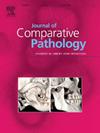Exploring the relationship between histological grading, fibrillar collagen alterations and nuclear phenotypes in canine mammary carcinomas
IF 0.9
4区 农林科学
Q4 PATHOLOGY
引用次数: 0
Abstract
We evaluated collagen deposition and nuclear phenotypes in non-inflammatory, metastasis-free canine mammary carcinomas at the time of tumour resection. A retrospective cohort analysis was conducted on 68 female dogs diagnosed with mammary carcinomas between January 2013 and December 2021, excluding cases of mammary sarcoma, carcinosarcoma, inflammatory mammary cancer and metastases. Tumours were classified into histological subtypes using the Peña grading system and assigned grades accordingly. Software-assisted video image analysis was utilized to quantitatively assess collagen deposition, organization and nuclear phenotypes. Histological grading was performed by three independent examiners to ensure reproducibility and minimize observer bias. Significant differences in collagen deposition and nuclear phenotypes were observed across histological grades. Grade III carcinomas had significantly greater collagen deposition, both within the tumour core and at the tumour periphery, compared with grades I and II. Collagen organization was markedly increased in grade III carcinomas. Nuclear phenotype analysis revealed distinct features that allowed clear differentiation between grade II and grade III tumours. Software-assisted image analysis effectively identified distinct patterns of collagen deposition, organization and nuclear phenotypes associated with canine mammary carcinomas of various grades, providing important information about tumour biology.

探讨犬乳腺癌组织学分级、原纤维胶原蛋白改变与细胞核表型的关系
我们评估了非炎症性、无转移的犬乳腺癌在肿瘤切除时的胶原沉积和核表型。对2013年1月至2021年12月期间诊断为乳腺癌的68只雌性犬进行回顾性队列分析,不包括乳腺肉瘤、癌性肉瘤、炎性乳腺癌和转移性乳腺癌。使用Peña分级系统将肿瘤分类为组织学亚型,并相应地进行分级。利用软件辅助视频图像分析定量评估胶原沉积、组织和核表型。组织学分级由三名独立审查员进行,以确保可重复性和最小化观察者偏差。胶原沉积和细胞核表型在不同的组织学级别上存在显著差异。与I级和II级相比,III级癌在肿瘤核心和肿瘤周围均有明显更多的胶原沉积。胶原组织在III级癌中明显增加。核表型分析揭示了II级和III级肿瘤之间的明确分化的独特特征。软件辅助图像分析有效地识别了与不同级别犬乳腺癌相关的胶原沉积、组织和核表型的不同模式,为肿瘤生物学提供了重要信息。
本文章由计算机程序翻译,如有差异,请以英文原文为准。
求助全文
约1分钟内获得全文
求助全文
来源期刊
CiteScore
1.60
自引率
0.00%
发文量
208
审稿时长
50 days
期刊介绍:
The Journal of Comparative Pathology is an International, English language, peer-reviewed journal which publishes full length articles, short papers and review articles of high scientific quality on all aspects of the pathology of the diseases of domesticated and other vertebrate animals.
Articles on human diseases are also included if they present features of special interest when viewed against the general background of vertebrate pathology.

 求助内容:
求助内容: 应助结果提醒方式:
应助结果提醒方式:


